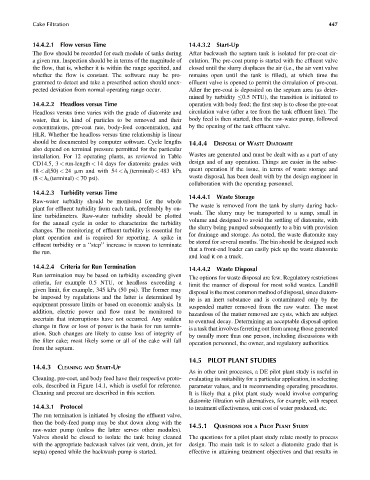Page 492 - Fundamentals of Water Treatment Unit Processes : Physical, Chemical, and Biological
P. 492
Cake Filtration 447
14.4.2.1 Flow versus Time 14.4.3.2 Start-Up
The flow should be recorded for each module of tanks during After backwash the septum tank is isolated for pre-coat cir-
a given run. Inspection should be in terms of the magnitude of culation. The pre-coat pump is started with the effluent valve
the flow, that is, whether it is within the range specified, and closed until the slurry displaces the air (i.e., the air vent valve
whether the flow is constant. The software may be pro- remains open until the tank is filled), at which time the
grammed to detect and take a prescribed action should unex- effluent valve is opened to permit the circulation of pre-coat.
pected deviation from normal operating range occur. After the pre-coat is deposited on the septum area (as deter-
mined by turbidity 0.5 NTU), the transition is initiated to
14.4.2.2 Headloss versus Time operation with body feed; the first step is to close the pre-coat
Headloss versus time varies with the grade of diatomite and circulation valve (after a tee from the tank effluent line). The
water, that is, kind of particles to be removed and their body feed is then started, then the raw-water pump, followed
concentrations, pre-coat rate, body-feed concentration, and by the opening of the tank effluent valve.
HLR. Whether the headloss versus time relationship is linear
should be documented by computer software. Cycle lengths 14.4.4 DISPOSAL OF WASTE DIATOMITE
also depend on terminal pressure permitted for the particular
installation. For 12 operating plants, as reviewed in Table Wastes are generated and must be dealt with as a part of any
CD14.5, 3 < run-length < 14 days for diatomite grades with design and of any operation. Things are easier in the subse-
18 < d(50) < 24 mm and with 54 < h L (terminal) < 483 kPa quent operation if the issue, in terms of waste storage and
(8 < h L (terminal) < 70 psi). waste disposal, has been dealt with by the design engineer in
collaboration with the operating personnel.
14.4.2.3 Turbidity versus Time
14.4.4.1 Waste Storage
Raw-water turbidity should be monitored for the whole
The waste is removed from the tank by slurry during back-
plant for effluent turbidity from each tank, preferably by on-
wash. The slurry may be transported to a sump, small in
line turbidimeters. Raw-water turbidity should be plotted
volume and designed to avoid the settling of diatomite, with
for the annual cycle in order to characterize the turbidity
the slurry being pumped subsequently to a bin with provision
changes. The monitoring of effluent turbidity is essential for
for drainage and storage. As noted, the waste diatomite may
plant operation and is required for reporting. A spike in
be stored for several months. The bin should be designed such
effluent turbidity or a ‘‘step’’ increase is reason to terminate
that a front-end loader can easily pick up the waste diatomite
the run.
and load it on a truck.
14.4.2.4 Criteria for Run Termination
14.4.4.2 Waste Disposal
Run termination may be based on turbidity exceeding given
The options for waste disposal are few. Regulatory restrictions
criteria, for example 0.5 NTU, or headloss exceeding a
limit the manner of disposal for most solid wastes. Landfill
given limit, for example, 345 kPa (50 psi). The former may
disposal is the most common method of disposal, since diatom-
be imposed by regulations and the latter is determined by
ite is an inert substance and is contaminated only by the
equipment pressure limits or based on economic analysis. In
suspended matter removed from the raw water. The most
addition, electric power and flow must be monitored to
hazardous of the matter removed are cysts, which are subject
ascertain that interruptions have not occurred. Any sudden
to eventual decay. Determining an acceptable disposal option
change in flow or loss of power is the basis for run termin-
is a task that involves ferreting out from among those generated
ation. Such changes are likely to cause loss of integrity of
by usually more than one person, including discussions with
the filter cake; most likely some or all of the cake will fall
operation personnel, the owner, and regulatory authorities.
from the septum.
14.5 PILOT PLANT STUDIES
14.4.3 CLEANING AND START-UP
As in other unit processes, a DE pilot plant study is useful in
Cleaning, pre-coat, and body feed have their respective proto- evaluating its suitability for a particular application, in selecting
cols, described in Figure 14.1, which is useful for reference. parameter values, and in recommending operating procedures.
Cleaning and precoat are described in this section. It is likely that a pilot plant study would involve comparing
diatomite filtration with alternatives, for example, with respect
14.4.3.1 Protocol to treatment effectiveness, unit cost of water produced, etc.
The run termination is initiated by closing the effluent valve,
then the body-feed pump may be shut down along with the
14.5.1 QUESTIONS FOR A PILOT PLANT STUDY
raw-water pump (unless the latter serves other modules).
Valves should be closed to isolate the tank being cleaned The questions for a pilot plant study relate mostly to process
with the appropriate backwash valves (air vent, drain, jet for design. The main task is to select a diatomite grade that is
septa) opened while the backwash pump is started. effective in attaining treatment objectives and that results in

